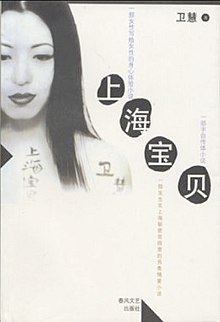Shanghai Babyis a novel written by Chinese authorWei Hui.It was originally published in China in 1999. The English translation was published in 2001.
 First edition | |
| Author | Wei Hui |
|---|---|
| Original title | 《 Thượng Hải bảo bối 》(Shànghǎi Bǎobèi) |
| Translator | Bruce Humes |
| Language | Chinese, translated into English and other languages |
| Publisher | Robinson PublishingUK |
Publication date | 2001 |
| Publication place | China |
| Media type | Print paperback & Audio book |
| Pages | 256 |
| ISBN | 1-84119-684-3 |
| OCLC | 51068741 |
| Followed by | Marrying Buddha |
Plot
editTwenty-five-year-old Nikki - whose friends call her Coco afterCoco Chanel– is a young Shanghainese writer, fascinated by theWestandWestern culture.A graduate ofFudan University,Coco has written a successful collection of short stories,The Shriek of the Butterfly,which, unusually for China, have sexually frank themes written from a woman's point of view. Coco now wants to embark upon her first novel, a semi-autobiographical work set in Shanghai.
The novel opens with Coco working as a waitress in a Shanghai cafe. Whilst at work, she meets a sensitive-looking young man, Tian Tian. Coco and Tian Tian start an intense relationship and Coco leaves her parents' home to move in with her new boyfriend. However, Tian Tian, a talented young artist, is extremely anxious and shy. His mother left him in the care of his grandmother when he was a small boy, after his father mysteriously died. Tian Tian now refuses to speak to his mother, who is living in Spain, although he lives off the money she sends him. Tian Tian's problems cause him to be completely impotent and unable to consummate his relationship with Coco.
Coco soon meets another man – a large, blond German named Mark who is living and working in Shanghai. Coco and Mark are intensely attracted to each other, and start anaffair,despite the fact that Mark is married and Coco is living with Tian Tian. Mark seems to want only pleasure from the affair, and Coco is torn between conflicting emotions.
Tian Tian, sensing that something is not right, becomes more and more withdrawn and starts to use drugs. He embarks on a trip to the South of China, leaving Coco alone in Shanghai. Coco continues her relationship with Mark, even after meeting his wife and child at a company-sponsored event.
Coco discovers that Tian Tian has become addicted tomorphine,and travels to him to bring him back to Shanghai, where he enters arehabcentre. Meanwhile, Tian Tian's mother returns fromSpainwith her husband. Mother and son are reunited, but Tian Tian is unable to overcome his hatred of her.
Mark tells Coco that he is moving back toBerlinand so the two must part. Coco spends several days in Mark's apartment. In her passion, she does not tell Tian Tian that she will be absent. When she returns to her own flat, she discovers that Tian Tian is gone and is at a friend's house. He has been informed of what he already suspected - that Coco is having an affair. Mark departs from Shanghai and Coco and Tian Tian resume living together. Shortly afterwards, Coco wakes up to find Tian Tian dead from aheroin overdose.
Reaction
editShanghai Babywasbannedin China.[1]
Inthe West,the reaction was mostly positive. It has been translated into English and other languages. In 2007, the novel was made into a filmShanghai Babydirected byBerengar Pfahland starring Chinese actressBai Lingin the lead role of Coco.[2][3]
Literature
edit- Sandra Lyne:Consuming Madame Chrysanthème: Loti's 'dolls' to Shanghai Baby
- "Young and Decadent in Shanghai",Die Gazette,February 2002
- "The Pen is Nastier than the Sword"Time Asia
- Wei Hui:Shanghai Baby,translated from the Chinese by Bruce Humes, Robinson 2001
External links
edit- Homepage of the 2007 movieShanghai Baby,directed by Berengar Pfahl
- Bruce Humes–interviewon the translation process andarticleatEthnic ChinaLit
References
edit- ^Melvin, Sheila (20 June 2000)."A Book Battle in China to Make the Critics Blush".The New York Times.Retrieved18 November2022.
- ^"Shanghai Baby".IMDb.Retrieved2022-05-13.
- ^Folie, Sandra (2022).Shanghai Baby (2007)(PDF).Bielefeld: transcript. pp. 287–290.ISBN978-3-8376-5973-3.